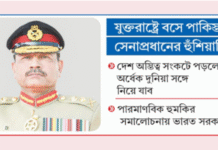
At least eight people turned victims of extrajudicial killings from August 9 to September 30 after the Professor Muhammad Yunus led interim government assumed power on August 8, according to a report by human rights organisation Odhikar published on Friday.
‘Of the eight, one died due to torture by the police, one died in torture by the members of the Department of Narcotics Control, and three were tortured to death by the joint forces. Additionally, three people were shot dead by the joint forces,’ said Odhikar in its quarterly report on the human rights situation from July to September.
From August 9 to September 30, at least 52 people were killed and 1,308 people were injured in political violence, the report said.
A total of 67 people were lynched in July and September, 2024. Of them, 36 were lynched from July 1 to August 5, and 31 were lynched from August 9 to September 30.
At least nine people, including four in August and five in September were killed in jail custody during the interim government after Sheikh Hasina resigned as prime minister and fled to India on August 5.
From August 9 to September 30, however, no cases of alleged enforced disappearances occurred.
According to statistics collected by Odhikar, from August 9 to September 30, four journalists were injured, two were assaulted, three were threatened, and cases were filed against three others while carrying out their professional duties.
At least 1,581 people, including children, were killed, and over 18,000 were injured during the students-led mass uprising from July 1 to August 5, the report mentioned citing Students Movement Against Discrimination, and Jatiya Nagorik Committee’s statistics.
The report also claimed that 550 people sustained injuries that damaged their eyesight.
‘The numbers are anticipated to be much higher as the counting continues. The mass killings perpetrated in July–August 2024 are the largest in the Bangladesh’s history of repression during protests,’ said the Odhikar report.
Besides mass killings, members of law enforcement agencies also abducted, arrested, and tortured student protesters, the report added.
When students all over the country took to the streets after Abu Sayeed’s murder, police and activists of Chhatra League and Juba League continued their violent attacks, said Obdhikar, adding that the then government began using the police, Border Guard Bangladesh, and specialised SWAT forces against the protesters.
During the July–August mass uprising, 10 people were forcefully disappeared and tortured and one of them still remained untraced, the report said, adding that five journalists were shot to death by the police while collecting news on the protests.
The Directorate General of Health Services, on September 24, came up with a preliminary list of 708 people who died in the student-led mass uprising.
On September 28, the health affairs sub-committee of the Student Movement Against Discrimination said that it had listed 1,581 deaths in the movement that overthrew authoritarian Sheikh Hasina regime.
Odhikar had been facing extreme state repression since 2013 from the authoritarian and repressive Awami League regime, said Odhikar.
After the collapse of the Awami regime, Odhikar has been able to prepare this third quarterly report without having to impose self-censorship.
It is due to the sacrifice of students and ordinary people of Bangladesh that human rights organisations like Odhikar are able to regain their voice, the human rights body said.
new age









